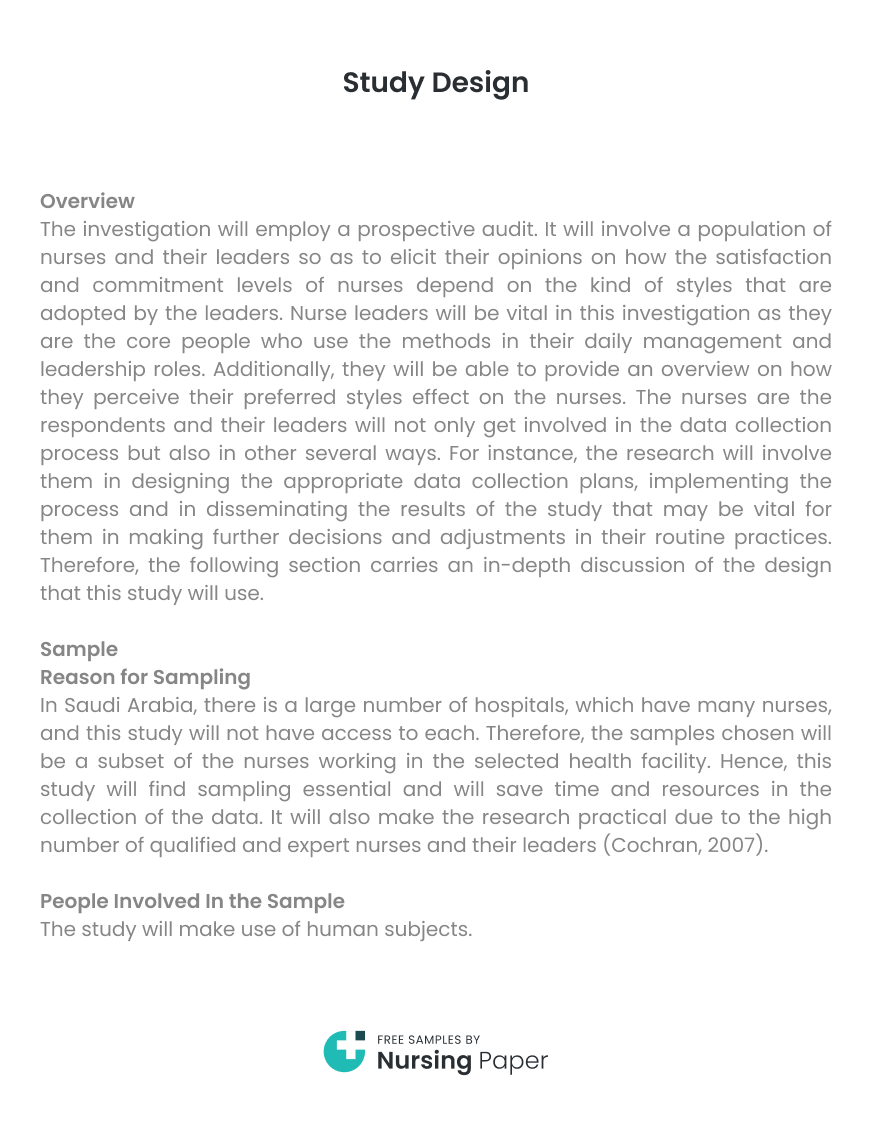1. Abdelhafiz, I.M., Alloubani, A.M.D. and Almatari, M, 2015, Impact of leadership styles adopted by head nurses on job satisfaction: a comparative study between governmental and private hospitals in Jordan. Journal of nursing management.
2. Abualrub, R.F. and Alghamdi, M.G, 2012, The impact of leadership styles on nurses’ satisfaction and intention to stay among Saudi nurses. Journal of nursing management, 20(5), pp.668-678.
3. Acharya, A.S., Prakash, A., Saxena, P. and Nigam, A, 2013, Sampling: Why and how of it. Indian Journal of Medical Specialties, 4(2), pp.330-333.
4. Almalki, M.J., FitzGerald, G. and Clark, M, 2012, The relationship between quality of work life and turnover intention of primary health care nurses in Saudi Arabia. BMC health services research, 12(1), p.314.
5. Artino Jr, A.R., La Rochelle, J.S., Dezee, K.J. and Gehlbach, H, 2014, Developing questionnaires for educational research: AMEE Guide No. 87. Medical teacher, 36(6), pp.463-474.
6. Bormann, L. and Abrahamson, K, 2014, Do staff nurse perceptions of nurse leadership behaviors influence staff nurse job satisfaction? The case of a hospital applying for Magnet® designation. Journal of Nursing Administration, 44(4), pp.219-225.
7. Bornstein, M.H., Jager, J. and Putnick, D.L, 2013, Sampling in developmental science: Situations, shortcomings, solutions, and standards. Developmental Review, 33(4), pp.357-370.
8. Boynton, P.M, 2004, Administering, analysing, and reporting your questionnaire. BMJ: British Medical Journal, 328(7452), p.1372.
9. Burns, N. and Grove, S.K, 2005, Using statistics to examine relationships. Burns N, Grove SK, eds. The Practice of Nursing Research: Conduct, Critique and Utilization. 5th ed. St. Louis, MO: Elsevier, pp.486-487.
10. Chang, L.C., Shih, C.H. and Lin, S.M, 2010, The mediating role of psychological empowerment on job satisfaction and organizational commitment for school health nurses: A cross-sectional questionnaire survey. International Journal of Nursing Studies, 47(4), pp.427-433.
11. Chaudhry, A.Q. and Javed, H, 2012, Impact of transactional and laissez faire leadership style on motivation. International Journal of Business and Social Science, 3(7).
12. Cochran, W.G, 2007, Sampling techniques. John Wiley & Sons.
13. Curtis, S., Gesler, W., Smith, G. and Washburn, S, 2000, Approaches to sampling and case selection in qualitative research: examples in the geography of health. Social science & medicine, 50(7), pp.1001-1014.
14. DeVon, H.A., Block, M.E., Moyle‐Wright, P., Ernst, D.M., Hayden, S.J., Lazzara, D.J., Savoy, S.M. and Kostas‐Polston, E, 2007, A psychometric toolbox for testing validity and reliability. Journal of Nursing scholarship, 39(2), pp.155-164.
15. Dörnyei, Z. and Taguchi, T, 2009, Questionnaires in second language research: Construction, administration, and processing. Routledge.
16. Fowler Jr, F.J, 2013, Survey research methods. Sage publications.
17. Handoll, H.H., Gillespie, W.J., Gillespie, L.D. and Madhok, R, 2008, The Cochrane Collaboration: a leading role in producing reliable evidence to inform healthcare decisions in musculoskeletal trauma and disorders. Indian journal of orthopaedics, 42(3), p.247.
18. Hines, J.E., Nichols, J.D., Royle, J.A., MacKenzie, D.I., Gopalaswamy, A.M., Kumar, N. and Karanth, K.U, 2010, Tigers on trails: occupancy modeling for cluster sampling. Ecological Applications, 20(5), pp.1456-1466.
19. Health Writer Hub, 2016, June 18, 7 Trusted Medical Journal Search Engines. Retrieved August 04, 2017, from Health Writer Hub: http://www.healthwriterhub.com/medical-journal-search-engines/
20. Horwitz, I.B., Horwitz, S.K., Daram, P., Brandt, M.L., Brunicardi, F.C. and Awad, S.S, 2008, Transformational, transactional, and passive-avoidant leadership characteristics of a surgical resident cohort: analysis using the multifactor leadership questionnaire and implications for improving surgical education curriculums. Journal of Surgical Research, 148(1), pp.49-59.
21. Kim, W.K. and Chung, K.H, 2008, The relationship between professional self-concept, organizational commitment and job satisfaction in clinical nurses. Journal of Korean Academy of Nursing Administration, 14(3), pp.287-296.
22. Kleinman, C, 2004, The relationship between managerial leadership behaviors and staff nurse retention. Hospital topics, 82(4), pp.2-9.
23. Laschinger, H.K.S., Finegan, J. and Wilk, P, 2009, Context matters: the impact of unit leadership and empowerment on nurses’ organizational commitment. Journal of Nursing Administration, 39(5), pp.228-235.

The download will start shortly.






 Subject:
Subject:
 Number of pages: 4
Number of pages: 4